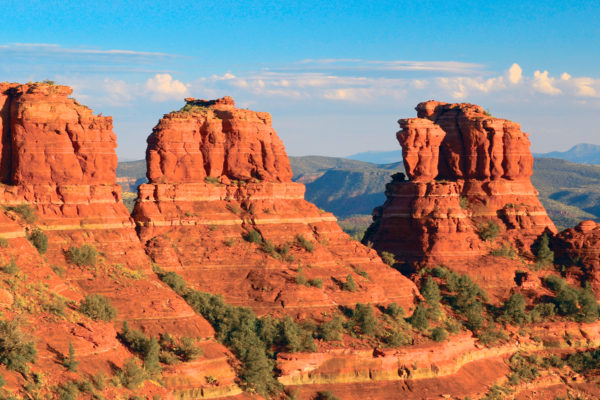TODAY
In the black cinder fields northeast of Flagstaff, the fierceness of the wind makes your eyes water and your nose run. Prickly brush grows from coal-colored sand, and gnarled pine trees stand sentinel. Occasionally, you can hear the sound of a trash truck – there is a landfill nearby – over the howling wind. As you trod through the powdery cinders, remnants from the explosion of nearby Sunset Crater nearly 1,000 years ago, you come upon depressions in the earth. Some are shallow, others are fairly deep with chaparral growing in their basin. The only evidence that you’re on hallowed ground comes in the form of a small white sign attached to a wire fence surrounding the perimeter of the craters. “During the late 1960s and early ’70s, the area behind this fence was used to train astronauts for the Apollo Space Program. Craters were blasted out with explosives and rocks [sic] brought in to simulate the surface of the moon. Here, astronauts learned to walk in space suits and use equipment to prepare for lunar missions. Similar areas were created in Texas and Florida, but no longer exist. This is the only remaining astronaut training area. Please help us protect this important part of American History.” Flagstaff’s role in the Space Race might come as a surprise to readers – it certainly was a surprise to us. Fortunately, Kevin Schindler, the historian at Lowell Observatory, and amateur astronomer and astronomy historian William Sheehan wrote a pictorial book, Northern Arizona Space Training (Arcadia Publishing; $26.99), last year that details the exercises that occurred in Flagstaff primarily between 1963 and 1972. (Astronauts have trained in northern Arizona as recently as the last 10 years for potential missions to Mars, says Kevin.) After reading it, we were left scratching our heads as to why it was the first time we were hearing about Arizona’s connection to the lunar landings. After all, when you think of places like Houston or Cape Canaveral, you automatically think of space exploration. With a little more promotion and preservation, Flagstaff could have been on that list. Household names like Buzz Aldrin, Neil Armstrong and Gene Cernan trained in the shadow of the San Francisco Peaks. Lunar rovers were built and tested in Flagstaff. The first space suits saw the light of day at Bonito Lava Flow near Sunset Crater in 1964. The moon was mapped at the United States Geological Survey in Flagstaff (more on that later) and at Lowell Observatory. The Lunar Flying Vehicle, a jetpack that propelled a person 30 feet in the air and traveled 10 miles per hour (think The Rocketeer), was first tested at Hopi Buttes in eastern Arizona. And one of our favorite fun facts: The tool carrier that astronauts used on the moon was designed on a napkin over cocktails at Hotel Monte Vista. Kevin has a few theories as to why this aspect of Flagstaff’s history isn’t acknowledged more often. “Science has been embedded in Flagstaff since its early days, going all the way back to John Wesley Powell,” he says. “Lowell Observatory opened in 1894, 18 years before Arizona was even a state. One of the oldest festivals of science happens here every year. At one time, there were more astronomers per capita in Flagstaff than in any part of the United States. I think science is ingrained in our culture and often taken for granted. When you think of Flagstaff tourism, you think of the outdoors, not science.” Then there’s the fact that many of the people involved in the space program were part of The Greatest Generation, a decidedly humble group who didn’t necessarily brag about their accomplishments. “The scientists and engineers had a job to do,” says Kevin. “They were proud of what they did, but they weren’t the ones creating the museums. Now that heritage is passing away from our collective consciousness. That’s why Bill and I decided to write the book.”
YESTERDAY
Flagstaff never would have entered the Space Race without Gene Shoemaker, a USGS geologist with a special place in his heart for northern Arizona. In 1959, it was Shoemaker who proved that Arizona’s Meteor Crater, the best-preserved impact crater on Earth, was, in fact, the result of a meteor. And it was Shoemaker who lobbied the federal government to put scientists on the moon. As strange as it might sound, NASA’s initial goal was to put an American on the moon, period. The astronauts were supposed to beat the Ruskies, not take snaphsots and collect rocks for the kiddies. Shoemaker was unable to convince the government to turn geologists into astronauts. Instead, NASA agreed to turn astronauts, who were test pilots by trade, into geologists. In order to do this, the pilots needed geological training and context for what they would encounter on the moon. What better place to do that, proposed Shoemaker, than northern Arizona? “Northern Arizona is so rich in resources,” says Kevin. “Astronauts trained in other places, but every astronaut who walked on the moon trained in Flagstaff. We have Meteor Crater, Sunset Crater, Lowell Observatory, the Grand Canyon, and we are the world’s first International Dark Sky Place. The first group of astronauts flew here in 1963 on two separate planes just in case one crashed. They were treated like rock stars – heroes who were going to save us from the Red Menace.” In 1967, they also had the Cinder Lake Crater Field. The field was built to resemble the surface of the moon complete with craters built to scale using explosives. (To see a video of how the fields were created, visit https://astrogeology.usgs.gov/rpif/videos/making-craters.) The original field, constructed in July, was 250,000 square feet and included 47 craters. It was expanded in October to include another 96 craters, bringing the training grounds to a total of 640,000 square feet. In 1968, a second field was built a short distance from the first. The craters ranged in diameter from 5 feet to 40 feet. Today, that second field is part of Cinder Hills OHV Area. Unlike the first field, there are no signs, however nondescript, identifying the historical significance of the second one, and it’s a bit disheartening to see ATV tracks through what was once a replica of the moon’s Sea of Tranquility. Of course, it gets snowy and cold in Flagstaff in the winter, so another crater field was built in 1970 on 35 acres near Cottonwood so astronauts could train under sunny skies. The craters there ranged from 6 to 82 feet in diameter. Good news: Black Canyon Crater Field isn’t a playground for off-road enthusiasts. But it’s located near AZ-260 and a housing development, and the craters are badly eroded. Retired USGS geologist Gerald Schaber was present when the Flagstaff crater field was built, and he spent time working at the Cottonwood location, too. Gerald’s story is the epitome of perfect timing. He graduated from University of Cincinnati with his Ph.D. at the same time that Gene Shoemaker and soon-to-be astronaut Harrison “Jack” Schmitt were recruiting grads to work for the Apollo astronauttraining program in Flagstaff in 1965. Gerald interviewed with Schmitt shortly before Gerald graduated, and a job offer was extended. On July 4, 1965, Gerald and his wife packed the car and drove to Flagstaff, arriving on July 7. “When I look back on that time, it’s not pride that I feel but the fact that I was so damn fortunate,” says Gerald, 79. “I earned the right degree at the right time from the right school. Within four years of arriving in Flagstaff, we put a man on the moon. We accomplished so much in such a short time.” Gerald was standing by when the dynamite that created the Flagstaff fields was detonated. “It was really something to see,” he says. Gerald, who retired from USGS in 1995, was at Mission Control in Houston during Apollo 11, 13, 14, 16 and 17. During the famed Apollo 11 moon landing, he was in the Science Operation Room, following the astronauts’ progress on a map. He says the entire experience is still vivid in his memory. “It was surreal, like an Einsteinian time warp,” he says. “Armstrong was so cool. I remember watching his heartbeats on the monitor. His heartrate was barely above normal, but that’s the way he always was. Aldrin’s heart was racing, though.” As someone who was intimately involved in the astronaut training in the 1960s (you can read his 1,161-page report at https://pubs.usgs.gov/of/2005/1190/), Gerald says he’s tried several times over the years to have a plaque placed at Cinder Lake Crater Field, but he thinks it might be the one instance in his life when timing isn’t on his side. “We were so busy planning Apollo missions at that time that we didn’t think about [preserving the site],” he says. “Before too long, the dune buggies found it. They ran over the fence and up and down the craters. We just didn’t get to it in time, and now there’s not much out there to see.” Peter Pilles, forest archaeologist for Coconino National Forest, the agency that manages the land where the crater field is located, says that starting 15 years ago, efforts have been made to preserve the field, but the mindset of the forest district staff hasn’t always been amenable to the idea. Getting the site added to the National Register of Historic Places is a lengthy process. Peter says it takes three to four months just to fill out the forms, and the forest service doesn’t have the manpower or funding for it. In the meantime, Friends of Northern Arizona Forests refenced the original field about five years ago. For now, the area is being treated similar to Native American archaeology sites.“We intend to protect, preserve and interpret it,” says Peter, “but that will mostly be done through volunteers like Friends of the Forest.”
TOMORROW
All isn’t lost, however. If you want to see an artifact from the Apollo missions, look no further than the USGS Flagstaff Science Campus near Buffalo Park. In the lobby of building six, you’ll find the dunebuggy-like geological lunar rover, nicknamed Grover, that was used to train for the Apollo 15, 16 and 17 missions. (Here’s a bit of trivia: Technician Dick Wiser worked on Grover. Wiser’s daughter, Sherry Mangum, would go on to co-author Sedona’s most popular hiking book, Sedona Hikes.) The lobby also includes a display on Gene Shoemaker, Neil Armstrong’s cement handprint (in a fruitcake tin) and models of spacecraft and rockets. Today, 200 people work on the campus, including 100 people devoted to planetary mapping. Book a tour (Monday through Friday, 9 a.m. to 5 p.m.) or take a selfguided one, and you’ll find out that an astonishing number of maps have been created in Flagstaff. When the Apollo astronauts were learning how to pick up rocks while wearing space suits over at Cinder Lake Crater Field, the geologists at the USGS campus were creating the first modern geologic maps of the moon. The campus has plans to add a map-making exhibit sometime within the next year. Archive manager David Portree, the man responsible for a collection that includes 120,000 maps, led us down a long hallway featuring a scale model of the solar system. He throws out nuggets of information here and there: Venus has been mapped in greater detail than any other planet. The farthest world USGS has mapped is Neptune’s moon Triton, which is 2.696 billion miles from Earth. Mercury’s topography is named after famous artists. The U.S. flag Neil Armstrong and Buzz Aldrin planted on the moon blew over when Apollo 11 took off. It’s laying on its side now, but there are five other U.S. flags on the moon. Part of the reason the Cassini spacecraft was forced to crash into Saturn last September was to protect Saturn’s moons from any organisms that might have been attached to the probe. But one of the most geek-worthy parts of the tour? We got a glimpse at the blinking bank of computers that holds all of the planetary data publicly available. How much storage does that require? A petabyte. (That’s more than 1 quadrillion bytes, for those keeping track.) The planetary mapping division of USGS receives its funding – and orders – from NASA. Looking around at the stacks of file folders in David’s office and at the globes depicting landmarks with unpronounceable Latin names, one has to wonder if David ever gets asked why. Why map planets and moons billions of miles away? “You mean, what do I say after I hit them in the nose?” he asks, laughing.“Look, if you don’t care about the unknown, you aren’t going to care about mapping. But this is our neighborhood. Not mapping other worlds would be like staying in your house all of the time.” July 20, 2019 will mark the 50th anniversary of the Apollo 11 moon landing. All in all, there were six missions to the moon beginning with Apollo 11 and ending with Apollo 17 in 1972. One of the Apollo 12 astronauts, Dick Gordon, lived in Sedona before his death in June of last year. Though Kevin has been lecturing about astronaut training in northern Arizona since 1996, even he made some discoveries. “I loved finding out how some of the equipment developed here found its way into pop culture – the James Bond film Thunderball, for example. But what struck me the most was how many different places and organizations in Flagstaff were involved in the Apollo missions. We’re talking the Museum of Northern Arizona, [Northern Arizona University], the U.S. Naval Observatory, USGS, Lowell Observatory, the National Parks Service. You walk around anywhere in Flagstaff, and you’ll find a person or place that was involved.” Even if they don’t realize it. Buildings on Huntington Road, East Street, Fourth Street, West Street and Mike’s Pike Street were leased to technicians and scientists in the 1960s. Kevin says he’s spoken to the current tenants in some of these locations, and they are surprised to learn what went on in their buildings 50-plus years ago. Kevin and the team at Lowell Observatory are hoping to change all of that with a series of events co-sponsored by the City of Flagstaff that will celebrate the 50th anniversary of the moon landing and Flagstaff’s role in that historic moment. Ideas being discussed include a parade, a “lunar trail,” school curriculum and tours to significant sites. Over at Johnson Space Center in Houston, Historic Preservation Officer Sandra Tetley says the Apollo Mission Control Center should be completely restored by May 2019 to celebrate the 50th anniversary. (NASA still holds the permit for Cinder Lake Crater Field.) Sandra confirmed that Cinder Lake is the last lunar simulation area that supported the Apollo Program that still exists. When asked about the site’s potential for being added to the national register, Sandra emailed us and said, “It should be!” So perhaps Flagstaff’s connection to the Apollo missions will finally get its due. “So much technology that we use today was an outgrowth of Apollo-era technology,” says Kevin. “How the moon was formed was figured out by collecting rocks, and the astronauts learned how to collect those rocks here in Flagstaff. But aside from the science, there’s a human element to that era, especially for Americans. We’re a culture of explorers. When Neil Armstrong walked on the moon, everyone walked on the moon.”




